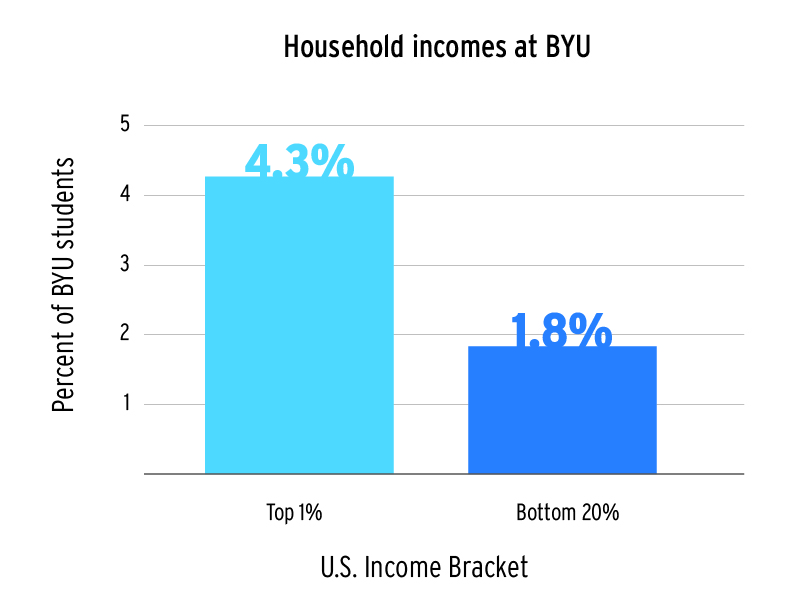
BYU scored poorly for social mobility in comparison to most other U.S. universities, according to a recent report released by a team of researchers led by Stanford University economics professor Raj Chetty.
The researchers viewed social mobility, or the movement in a society of people within or between social strata, in terms of colleges. According to the report, “The Equality of Opportunity Project,” Chetty and his team wanted to answer the questions, “Which colleges in America contribute the most to helping children climb the income ladder?” and “How can we increase access to such colleges for children from low income families?”
BYU ranked 2,125 out of the 2,137 colleges the report measured, with only 12 colleges scoring worse than BYU.

Statistics from the study show only 1.8 percent of BYU students come from the bottom 20 percent of U.S. household incomes, while 60 percent of students come from the top 20 percent of U.S. household incomes. Additionally, the median individual income for BYU graduates at the age of 34 is $32,600, which is among the lowest of the other private colleges in the study.
In a statement to the Daily Universe, University Communications spokesman Todd Hollingshead explained the ways BYU reaches out to students from low-income households.
“For almost two decades, BYU has been working to prepare underrepresented students with the skills and knowledge to further their education,” Hollingshead said. “Through the SOAR (Summer of Academic Refinement) program, BYU has helped about 5,000 students prepare to attend BYU or another institution.”
Hollingshead also said BYU provides many opportunities for students to earn money while attending BYU, which is helpful to those who may not receive financial support from their families to pay for college. BYU provides jobs for about 15,000 students each year, according to BYU Admissions.
“For many students, these jobs allow them to work part-time while attending school full-time,” Hollingshead said.
BYU economics professor David Sims said this study is the first to analyze social mobility for colleges in a systematic, heavily data-driven way.
“If you look at the study in terms of which students go to which universities, you’ll find that BYU looks a lot like elite, selective private colleges,” Sims said.
Sims said this goes along with the pattern of BYU becoming more selective and raising the admittance bar each year.
“The average credentials of the students have climbed,” Sims said. “They increasingly look like student bodies at other top private universities, and if you look at the studies, it’s the characteristics of other top private universities that they have far more students from the top of the income distribution.”
Sims said the colleges that scored high for social mobility in the study are located in major cities serving a heavily diverse and immigrant population.
“Immigrants typically have very, very high economic mobility from first to second generation,” Sims said. “These are universities that serve a clientele of students who are inherently upwardly mobile.”
BYU scored low in comparison to other colleges for alumni’s median individual income at the age of 34, but this statistic is largely unbalanced when looking at men and women separately. Male BYU graduates have a median individual income of $71,900, while female graduates have a median individual income of $800, according to the report.
“BYU has a very high population of alumni women who have lower incomes, but that’s by choice,” Sims said. “It does not reflect the fact that they would not have a lot of income potential in the labor market, but many are choosing not to exercise it five or six years out of school.”
Orem resident Courtney Bodily earned a bachelor’s degree in English from BYU in 2011, and a master’s degree in linguistics from BYU in 2013. She is now a stay-at-home mom without an individual income.
Bodily said she originally thought she would never be a mom who would let family priorities outweigh career goals.
“But once I had my kids I realized that for me, they are my goal,” Bodily said. “I realized I really only get one chance to raise my kids, but I will have future chances to enjoy a career.”
Sims said the LDS Church Education System as a whole should be considered when looking at social mobility, rather than just BYU on its own.
“The church has a lot of other higher education programs, and as a group they’re trying to serve the population as a whole,” Sims said. “For example, the Pathways program is targeted almost entirely at people in the lower income distribution.”
Sims said the multiple education opportunities from the LDS church are designed to work together in a group to serve people from the full spectrum of household incomes.




